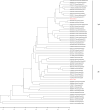High prevalence of hepatitis E and rat hepatitis E viruses in wastewater in Gothenburg, Sweden
- PMID: 39267918
- PMCID: PMC11391864
- DOI: 10.1016/j.onehlt.2024.100882
High prevalence of hepatitis E and rat hepatitis E viruses in wastewater in Gothenburg, Sweden
Erratum in
-
Corrigendum to: "High prevalence of hepatitis E and rat hepatitis E viruses in wastewater in Gothenburg, Sweden" [One Health, volume 19, article number 100882].One Health. 2024 Oct 18;19:100920. doi: 10.1016/j.onehlt.2024.100920. eCollection 2024 Dec. One Health. 2024. PMID: 39802067 Free PMC article.
Abstract
Hepatitis E virus (HEV) and Rat Hepatitis E virus (RHEV), recognized for their zoonotic potential, pose significant public health concerns. Our previous research identified both viruses in effluent wastewater in Gothenburg, Sweden. However, there are lingering inquiries regarding the prevalence and genetic diversity of these viruses in influent wastewater, as well as the utility of wastewater surveillance in elucidating their community circulation dynamics. To address these knowledge gaps, we conducted weekly collection of wastewater samples at the Rya wastewater treatment plant in Gothenburg throughout 2023. The concentrations of HEV and RHEV were quantified using quantitative polymerase chain reaction (qPCR). Additionally, two semi/nested-PCR were utilized to amplify viral strains. Furthermore, HEV strains from patients within the same region, as well as other regions in Sweden in 2023, were incorporated into the analysis. Remarkably, we observed a high prevalence of HEV (86%) and RHEV (98%) in wastewater samples, with the majority of HEV sequences identified as subtype 3c/i (9/12). In contrast, HEV subtype 3f was the most sequenced among clinical patient samples (6/12). Notably, previously unreported HEV-3b and unclassified strains were detected in wastewater. Almost all RHEV strains (20/21) were clustered into European groups, with none of the RHEV genetically close to strains previously found in human cases. The notable discordance in prevalence and identified subtypes of HEV-3 in wastewater compared to clinical samples suggests either a significant underdiagnosis of HEV infections or differences in viral loads and shedding durations among humans between HEV-3 subtypes. This underscores the urgent need for improved diagnostic techniques and heightened awareness of HEV transmission dynamics. Furthermore, the consistent detection of RHEV in wastewater underscores the necessity for further investigations to assess the potential role of RHEV in hepatitis cases of unknown etiology, given that most currently available clinical diagnostic assays fail to detect RHEV.
Keywords: HEV-C; Sewage; Subtype; Surveillance; Wastewater-based epidemiology; Zoonotic transmission.
© 2024 The Authors.
Conflict of interest statement
The authors declare that they have no known competing financial interests or personal relationships that could have appeared to influence the work reported in this article.
Figures




Similar articles
-
Environmental Surveillance of Hepatitis E Virus and Rat Hepatitis E Virus in Portugal and Spain, 2020-2022.J Med Virol. 2025 May;97(5):e70414. doi: 10.1002/jmv.70414. J Med Virol. 2025. PMID: 40407063
-
Correlation of hepatitis E and rat hepatitis E viruses urban wastewater monitoring and clinical cases.Sci Total Environ. 2024 Jan 15;908:168203. doi: 10.1016/j.scitotenv.2023.168203. Epub 2023 Oct 31. Sci Total Environ. 2024. PMID: 37914110
-
Variations among Viruses in Influent Water and Effluent Water at a Wastewater Plant over One Year as Assessed by Quantitative PCR and Metagenomics.Appl Environ Microbiol. 2020 Nov 24;86(24):e02073-20. doi: 10.1128/AEM.02073-20. Print 2020 Nov 24. Appl Environ Microbiol. 2020. PMID: 33036988 Free PMC article.
-
An overview: Rabbit hepatitis E virus (HEV) and rabbit providing an animal model for HEV study.Rev Med Virol. 2018 Jan;28(1). doi: 10.1002/rmv.1961. Epub 2017 Nov 17. Rev Med Virol. 2018. PMID: 29148605 Review.
-
Epidemiology Update of Hepatitis E Virus (HEV) in Uruguay: Subtyping, Environmental Surveillance and Zoonotic Transmission.Viruses. 2023 Sep 27;15(10):2006. doi: 10.3390/v15102006. Viruses. 2023. PMID: 37896784 Free PMC article. Review.
Cited by
-
Rat Hepatitis E Virus (Rocahepevirus ratti): A Systematic Review of Its Presence in Water, Food-Related Matrices, and Potential Risks to Human Health.Foods. 2025 Jul 19;14(14):2533. doi: 10.3390/foods14142533. Foods. 2025. PMID: 40724353 Free PMC article. Review.
-
Distinct distribution of HEV-3 subtypes across humans, animals, and environmental waters in Sweden.Emerg Microbes Infect. 2025 Dec;14(1):2488188. doi: 10.1080/22221751.2025.2488188. Epub 2025 Apr 15. Emerg Microbes Infect. 2025. PMID: 40166982 Free PMC article.
References
-
- International Committee on Taxonomy of Viruses Hepeviridae Study, Family: Hepeviridae. 2022. https://ictv.global/report/chapter/hepeviridae/hepeviridae
-
- Smith D.B., Izopet J., Nicot F., Simmonds P., Jameel S., Meng X.J., Norder H., Okamoto H., van der Poel W.H.M., Reuter G., Purdy M.A. Update: proposed reference sequences for subtypes of hepatitis E virus (species Orthohepevirus A) J. Gen. Virol. 2020;101(7):692–698. doi: 10.1099/jgv.0.001435. - DOI - PMC - PubMed
LinkOut - more resources
Full Text Sources

